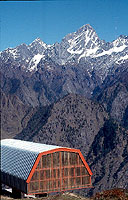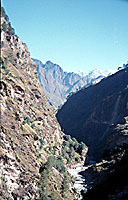India
Himalayan Journey
(Chopta, Tsungnath, Josimath, Auli)
Rishikesh is the starting point for one of the most important pilgrimmanges in India, the Char Dham Yatra ("four temple pilgrimmage"), a trip to 4 very high temples in the snowy Himalayas at about 10000 ft above sea level. These 4 temples, located in Badrinath, Kedernath, Gangotri and Yamunotri, are temples that were founded by the Indian Sage Shankara in the 8th century, upon the recession of Buddhism in India. These temples represent some of the most sacred places in all of India, partly in that they have been consistently in place for centuries.
Since my time is short (it takes almost 2 weeks to see them all), my plan is to get to Badrinath, or as close as possible to Badrinath, which according to Beehm, offers the best Himalayan views on the way. Apparently Badrinath is a place where Vivekananda had a major awakening.
 The day before I left, Beehm gave me the news
that the road to Badrinath was closed due
to landslides and snow, which is a minor
disappointment, but he works out a very
interesting itinerary - Josimath, the town
closest to Badrinath is the base of Auli,
a ski area that offers a 180 degree view
of the highest peaks in the Indian Himalayas,
and Chopta, a 9000 ft town that marks the
starting point to yet another temple that
was founded by Shankara, called Tungnath,
one of 5 other lesser known temples in the
area. Shankara died when he was 33 years
old, and accomplished a lot in 33 years.
The day before I left, Beehm gave me the news
that the road to Badrinath was closed due
to landslides and snow, which is a minor
disappointment, but he works out a very
interesting itinerary - Josimath, the town
closest to Badrinath is the base of Auli,
a ski area that offers a 180 degree view
of the highest peaks in the Indian Himalayas,
and Chopta, a 9000 ft town that marks the
starting point to yet another temple that
was founded by Shankara, called Tungnath,
one of 5 other lesser known temples in the
area. Shankara died when he was 33 years
old, and accomplished a lot in 33 years.
So I pay Beehm about 150 dollars for the three day trip, which is expensive by Indian standards, but my experience so far with Beehm is that he is responsible and professional. The 150 includes a guide as well as a driver, who again will be Kuku, which I like very much, as I trust him completely on the wild and zany Indian roads. He introduces me to Hari, a young Indian adventure guide/jock. I immediately take a liking to Hari who is very personable and has that youthful, bubbly thing going on. The only problem with Hari is that his English isn't that great, which concerns me. Hari sounds exactly like the Indian convenience store man on the Simpsons show, a perfect stereotype of the Indian accent. It's easy to talk Hindi-English, just curl your lips out and talk with your teeth closed, it's a starting point at least. Beehm is also concerned, so he assigns me another guide, Sumet, who speaks perfect English, and apparently is Hari's childhood friend. The concerns me a bit, the dynamic, and I am bummed that I won't have the backseat of the taxi all to myself.
But when we pile into Kuku's impeccably clean taxi (Kuku even was a little upset the previous day because I shifted his floormats a bit - wow an Indian with an anal streak!), all three pile into the front seat of the car. Now I feel bad that they have to squish together for three days, but not that bad to offer the backseat. Hey, I'm the important, rich white guy, I should get the backseat. Besides, once I got to know Sumet, I realize that he would have declined anyhow.
So we take off into the Himalayan high country. Despite Kukus driving skill, any bit of bad luck could spell doom for our heroes here, and a few concerned thought pass through now and then.
The reason being is that despite the
impressive engineering job building
these roads, they are built to be
the in barest minimal working conditions.
For a country of 986 million the size
of the western US, minimal-optimal
is the going standard.
 This means that
we encounter all sorts of driving
conditions - the road goes from bumpy
paved to lunar land surface in seconds
with big pot-holes and sections of
missing road, in addition to the
numerous streams that we must ford,
all on a 1.5 lane road halfway up
a 1000 to 8000 foot mountain. The
Indian designed the road around
waterfalls to be part of the waterfall,
with special, rocky concrete to
do the job. But waterfalls spring up
all over the place, making certain
sections of the highway like a Malibu
beach "sand dune buggy along the
shore" kind of drive, to scary mud bog.
This means that
we encounter all sorts of driving
conditions - the road goes from bumpy
paved to lunar land surface in seconds
with big pot-holes and sections of
missing road, in addition to the
numerous streams that we must ford,
all on a 1.5 lane road halfway up
a 1000 to 8000 foot mountain. The
Indian designed the road around
waterfalls to be part of the waterfall,
with special, rocky concrete to
do the job. But waterfalls spring up
all over the place, making certain
sections of the highway like a Malibu
beach "sand dune buggy along the
shore" kind of drive, to scary mud bog.
And I haven't even gotten to the worst part, the constant landslides. Since I saw perhaps two vehicles for road work/repair the whole trip, most of the work is done by a bunch of guys with a shovel - it looks like the Uttar Pradesh state hires the kujas to be responsible for certain sections of the road. But people power can only go so far, and therefore, at a landslide, an even smaller one lane road is built out of the newly dump dirt and rock. And this is pretty treacherous for car undercarriages and such.
The road crews have an interesting technique - one guy shovels while another ties a rope to the shovel handle down by the blade and help pull when the main shoveler is ready to pick up. Now that's teamwork. And may I mention that there's no glass ceiling in the road crew in the Himalayan highlands - I saw plenty of women dumping dirt and moving rocks. I saw one family where the husband and wife pick up pile of dirt in a big blanket and dump it over the side; meanwhile their two year old baby plays about 20 feet away in a small hole that is about two feet from a 5000 foot cliff. Life on the edge literally. Hari informs me that the Uttar Pradesh transportation bureau is incredibly corrupt. I believe him.
 So with all that to deal with, Kuku must
manage the road traffic. Customary with
all drivers in India, especially taxis,
he blows his horn before coming into
a curve, and has that certain capacity
to always be looking ahead to know if
traffic is coming our way, since you get
a long distance view of the road ahead
in the Himalayas - for the most part -
we had several situations where a big,
big truck or bus arrived at the same
1.5 lane curve exactly the same time
the car did and Kuku handled with
optimal efficiency, knowing exactly how
much room there is near the cliff of
several thousand feet on one side, and
the truck on the other. He's a pro at
this and he does this at a maximal speed
that sometimes is scary, even for me,
who likes to go fast. But he is impeccable
as a driver, and I think he could give
any NASCAR driver a run for his money
given the chance. And those Ambassador
taxis sure take a lickin' and keep on
tickin'. Well built cars. And another
thing about Kuku is that he hardly ate
for our trip, and when we stopped for
the night, he slept in his taxi, and
at times we found him working on
a friends taxi when we were stopped
in a town. He is a transportation God,
from the realm where all good taxi
drivers emanate, which are few.
So with all that to deal with, Kuku must
manage the road traffic. Customary with
all drivers in India, especially taxis,
he blows his horn before coming into
a curve, and has that certain capacity
to always be looking ahead to know if
traffic is coming our way, since you get
a long distance view of the road ahead
in the Himalayas - for the most part -
we had several situations where a big,
big truck or bus arrived at the same
1.5 lane curve exactly the same time
the car did and Kuku handled with
optimal efficiency, knowing exactly how
much room there is near the cliff of
several thousand feet on one side, and
the truck on the other. He's a pro at
this and he does this at a maximal speed
that sometimes is scary, even for me,
who likes to go fast. But he is impeccable
as a driver, and I think he could give
any NASCAR driver a run for his money
given the chance. And those Ambassador
taxis sure take a lickin' and keep on
tickin'. Well built cars. And another
thing about Kuku is that he hardly ate
for our trip, and when we stopped for
the night, he slept in his taxi, and
at times we found him working on
a friends taxi when we were stopped
in a town. He is a transportation God,
from the realm where all good taxi
drivers emanate, which are few.
Road Signs
Driving along the roadside, we pass cute signs in the Hindi-English style which is supposed to help drivers slow down. Here's a sampling:
"Remember God"
"Life is Short. Don't make it shorter"
"Not to worry. Eat curry, Don't hurry"
"Be bright around blind curves"
and my favorites:
"Darling I Love You, But Not So Fast!"
"Pay Attention to My Curves"
(someone apparently told the
sign painter the exact meaning
of this, so he painted out
the word "My")
and last but not least:
Erive Carefully
Along the way, I make conversation with Hari and Sumet. Hari asks me a whole mess of question about sports, but I have a hard time understanding at time, which then Sumet stands in and gives me a clearer wording. At one point, we're talking about big tennis servers, and he asks me if I know Goran Ivanesovic - do you have any idea how Goran Ivanesovic sounds like in a thick Hindi accent? By listening close to Hari, Hindi reminds me a bit of Spanish, concise and spoken fast, with little space between words. He has great pride in India, especially the Indian cricket team. I know nothing about cricket and don't have the heart to tell Hari that I don't believe it's a real sport.
 Back |
 Himalayas, con't. |
|
|
Page 12. |
||
